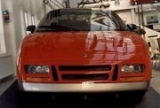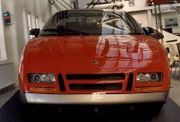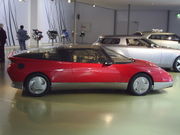
Saab EV-1
Encyclopedia
Not to be confused with the General Motors EV1

 Saab EV-1, or Saab 900 Turbo EV-1, was developed by Saab
Saab EV-1, or Saab 900 Turbo EV-1, was developed by Saab
in 1985 as a fully functional and roadworthy future design
study (EV-1 stands for Experimental Vehicle One). It was a wedge-shaped 2 + 2 sports coupé
body style
based on the Saab 900
Turbo 16v. The body was steel and the roof all glass. The design was made by Björn Envall
and the metal work was done by Leif Mellberg included such features as a solar power
ed interior cooling fan with 66 solar cell
s mounted in the glass roof. This device cooled the car when parked in sunlight. The front and rear bumpers (fenders
) were designed to absorb impacts and revert to their original shape. They were made of Aramid
fibre (Twaron
or Kevlar
) reinforced composites
. The side doors featured carbon-fibre side impact protection. Most of the parts were from the Saab 900 Turbo 16 and modified, but the seats came from a Chevrolet Corvette
. The engine
was tuned
to give 285 hp
(213 kW). The top speed was 270 km/h (168 mph) and 0 to 100 km/h (62 mph) acceleration took 5.9 seconds. An interesting feature is that the speedometer lights only illuminate the area around the current speed; a modified version of this feature has been incorporated as standard on later production Saab models.
The windshield
is wrap-around and very deep and steeply inclined for the era, while the A-pillar
has a much more vertical angle, providing excellent driver visibility
.
An EV-1 can be seen in the background of Back to the Future Part II
.
General Motors EV1
The General Motors EV1 was an electric car produced and leased by the General Motors Corporation from 1996 to 1999. It was the first mass-produced and purpose-designed electric vehicle of the modern era from a major automaker, and the first GM car designed to be an electric vehicle from the...


Saab Automobile
Saab Automobile AB, better known as Saab , is a Swedish car manufacturer owned by Dutch automobile manufacturer Swedish Automobile NV, formerly Spyker Cars NV. It is the exclusive automobile Royal Warrant holder as appointed by the King of Sweden...
in 1985 as a fully functional and roadworthy future design
Design
Design as a noun informally refers to a plan or convention for the construction of an object or a system while “to design” refers to making this plan...
study (EV-1 stands for Experimental Vehicle One). It was a wedge-shaped 2 + 2 sports coupé
Coupé
A coupé or coupe is a closed car body style , the precise definition of which varies from manufacturer to manufacturer, and over time...
body style
Car body style
Automobiles' body styles are highly variable. Some body styles remain in production, while others become less common or obsolete. They may or may not correlate to a car's price, size or intended market classification. The same car model might be available in multiple body styles comprising a...
based on the Saab 900
Saab 900
The Saab 900 was a car produced by Saab Automobile from 1978 until 1998 in two generations. The first generation from 1978 to 1993 is known as the "classic"; the generation from 1994 to 1998 is known as the "new generation" ....
Turbo 16v. The body was steel and the roof all glass. The design was made by Björn Envall
Björn Envall
Björn Envall, born in 1942, is a retired automobile designer. He was head of the design department at Saab.He started his career in the 1960s at Saab as an apprentice under Sixten Sason, especially helping with the design of the Saab 99 and the ill-fated Saab Catherina sports car...
and the metal work was done by Leif Mellberg included such features as a solar power
Solar power
Solar energy, radiant light and heat from the sun, has been harnessed by humans since ancient times using a range of ever-evolving technologies. Solar radiation, along with secondary solar-powered resources such as wind and wave power, hydroelectricity and biomass, account for most of the available...
ed interior cooling fan with 66 solar cell
Solar cell
A solar cell is a solid state electrical device that converts the energy of light directly into electricity by the photovoltaic effect....
s mounted in the glass roof. This device cooled the car when parked in sunlight. The front and rear bumpers (fenders
Fender (vehicle)
Fender is the US English term for the part of an automobile, motorcycle or other vehicle body that frames a wheel well . Its primary purpose is to prevent sand, mud, rocks, liquids, and other road spray from being thrown into the air by the rotating tire. Fenders are typically rigid and can be...
) were designed to absorb impacts and revert to their original shape. They were made of Aramid
Aramid
Aramid fibers are a class of heat-resistant and strong synthetic fibers. They are used in aerospace and military applications, for ballistic rated body armor fabric and ballistic composites, in bicycle tires, and as an asbestos substitute. The name is a portmanteau of "aromatic polyamide"...
fibre (Twaron
Twaron
Twaron is the brandname of Teijin Aramid for a para-aramid. It is a heat-resistant and strong synthetic fibre developed in the early 1970s by the Dutch company AKZO, division Enka, later Akzo Industrial Fibers. The research name of the para-aramid fibre was originally Fiber X, but it was soon...
or Kevlar
Kevlar
Kevlar is the registered trademark for a para-aramid synthetic fiber, related to other aramids such as Nomex and Technora. Developed at DuPont in 1965, this high strength material was first commercially used in the early 1970s as a replacement for steel in racing tires...
) reinforced composites
Composite material
Composite materials, often shortened to composites or called composition materials, are engineered or naturally occurring materials made from two or more constituent materials with significantly different physical or chemical properties which remain separate and distinct at the macroscopic or...
. The side doors featured carbon-fibre side impact protection. Most of the parts were from the Saab 900 Turbo 16 and modified, but the seats came from a Chevrolet Corvette
Chevrolet Corvette
The Chevrolet Corvette is a sports car by the Chevrolet division of General Motors that has been produced in six generations. The first model, a convertible, was designed by Harley Earl and introduced at the GM Motorama in 1953 as a concept show car. Myron Scott is credited for naming the car after...
. The engine
Internal combustion engine
The internal combustion engine is an engine in which the combustion of a fuel occurs with an oxidizer in a combustion chamber. In an internal combustion engine, the expansion of the high-temperature and high -pressure gases produced by combustion apply direct force to some component of the engine...
was tuned
Engine tuning
Engine tuning is the adjustment, modification or design of internal combustion engines to yield optimal performance, to increase an engine's power output, economy, or durability....
to give 285 hp
Horsepower
Horsepower is the name of several units of measurement of power. The most common definitions equal between 735.5 and 750 watts.Horsepower was originally defined to compare the output of steam engines with the power of draft horses in continuous operation. The unit was widely adopted to measure the...
(213 kW). The top speed was 270 km/h (168 mph) and 0 to 100 km/h (62 mph) acceleration took 5.9 seconds. An interesting feature is that the speedometer lights only illuminate the area around the current speed; a modified version of this feature has been incorporated as standard on later production Saab models.
The windshield
Windshield
The windshield or windscreen of an aircraft, car, bus, motorbike or tram is the front window. Modern windshields are generally made of laminated safety glass, a type of treated glass, which consists of two curved sheets of glass with a plastic layer laminated between them for safety, and are glued...
is wrap-around and very deep and steeply inclined for the era, while the A-pillar
Pillar (car)
Pillars are the vertical supports of the greenhouse of an automobile — known respectively as the A, B, C or D-pillar moving in profile view from the front to rear....
has a much more vertical angle, providing excellent driver visibility
Driver visibility
In transport, driver visibility is the maximum distance at which the driver of a vehicle can see and identify prominent objects around the vehicle. Visibility is primarily determined by weather conditions and by a vehicle's design. The parts of a vehicle that influence visibility include the...
.
An EV-1 can be seen in the background of Back to the Future Part II
Back to the Future Part II
Back to the Future Part II is a 1989 American science fiction comedy film and the second installment of the Back to the Future trilogy. It was directed by Robert Zemeckis, written by Zemeckis and Bob Gale, and starred Michael J. Fox, Christopher Lloyd, Thomas F. Wilson and Lea Thompson...
.

